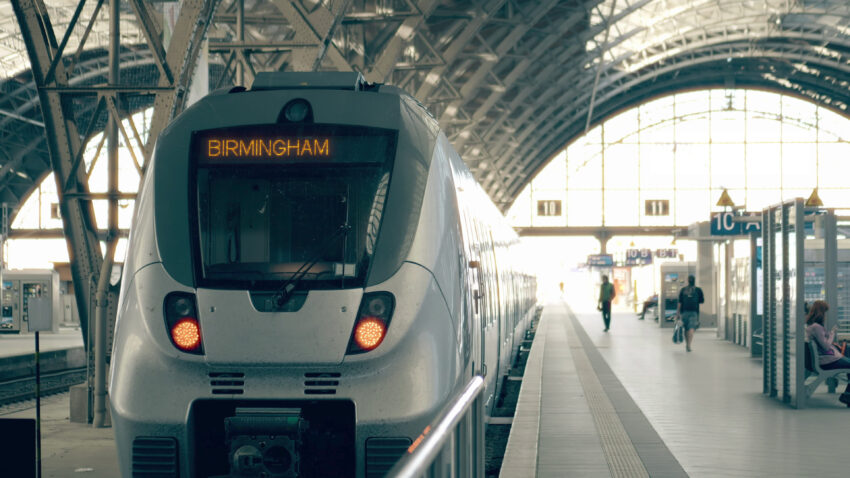Founder of the Institute for Emerging Technologies & Social Impact (ITSI) Guo Qiang discusses the future of transport in the UK.
Britain is pursuing the simultaneous expansion, upgrade and decarbonisation of the country’s railways, as it strives to achieve its goal of net-zero emissions by 2050. Yet reports of plans to cut expenditure on the rail network in the wake of last month’s substantial revision of major investments has raised concerns over the level of commitment to the transport strategy.
The UK is promoting passenger and freight rail services as part of efforts to reduce the volume of polluting cars and heavy goods vehicles on the roads. At the same time, it is aiming to replace diesel-powered trains with ones driven by cleaner energy, such as electricity and hydrogen.
As electric vehicle use is still relatively small and Britain’s roads are amongst the most congested in Europe, the prioritisation of low-carbon transport through the development of a better-connected, more widely used decarbonised railway system could contribute significantly to curbing UK emissions.
In November, the government launched what it described as the biggest-ever public investment in the British rail network, the £96 billion Integrated Rail Plan (IRP), including new lines and upgrades in the Midlands and northern England. But the programme provoked a storm of controversy by scaling back proposed rail links between towns and cities in the north and the scrapping of an extension of a high-speed rail link to London, known as HS2. Both the highly anticipated transport infrastructure initiatives were widely seen as key to bolstering regional economies, otherwise known as ‘levelling up’.
Nonetheless, the revised rail investments contained a large package of significant rail network enhancements, which the government argued would “deliver faster, more frequent and more reliable journeys” across the North and Midlands, far sooner than was previously envisaged. Yet some rail industry representatives felt that leaving out important elements of the original plan would “hold back the ability of the railways to power the levelling up agenda and the drive to net zero”. Others said that given the cuts “it was difficult to see this IRP as anything other than a piecemeal approach to national strategic railway infrastructure development”.
While the disappointment is understandable, there is still much to commend in the IRP, not least plans for the electrification of more than 180 miles of track. As a result, the government says, 75 per cent of the country’s main lines will be electric – helping to meet the ambition of removing all diesel-only trains from the network by 2040 and, in so doing, advance the UK’s net-zero emissions goal. In addition to electrification, the government is looking to support the development of hydrogen and battery-powered trains and use technology to clean up diesel engines in advance of their eventual removal.
Britain lags well behind its European neighbours on rail electrification. Currently, only 38 per cent of the UK network is electrified, compared to 61 per cent in German and 76 per cent in Italy, with the British shadow transport minister Tan Dhesi critical of the government for not prioritising the transition earlier. Yet even now that it has, there is concern that it is not moving fast enough. Figures released in November by the regulatory and monitoring agency the Office of Road and Rail indicated that the current rate at which track is electrified is not sufficient to meet carbon emission targets.
More encouragingly, there have been some important breakthroughs in other climate-friendly train propulsion technologies, with news that the train manufacturer Alstom is planning to build a hydrogen-powered train fleet for the UK. Separately, trials of a prototype, developed by the University of Birmingham and rolling stock company Porterbrook, have been underway, and it is hoped that that technology being employed could be used to retrofit current in-service trains by 2023.
Also in its infancy is the use of batteries to power trains. One of the main challenges is their energy storage capacity. Yet they still have role to play in hybrid propulsion designs. Recent technological innovation allow trains to run on electricity and diesel, the latter used when the former is unavailable. Accounting for 7 per cent of the total passenger fleet, so-called bi-mode trains are plugging gaps in the transition to more extensive electrification. Tri-mode variants that include the option of battery propulsion could play a similar role. Some industry players believe a full battery-powered intercity train might be developed by the late 2040s.
To maintain the IRP’s credibility, the government will need to robustly back these new power technologies and press ahead with upgrades and expansion of lines. That may be challenging as budgets are likely to come under pressure, as recent reports of train operators having to make savings suggest. Yet early delivery of projects offering better links between towns and cities will be important to restore public confidence in the railways, badly hit by the pandemic with passenger numbers still substantially down on pre-crisis levels. For ultimately, a cleaner railway might not fulfil its potential to contribute to net-zero targets unless car drivers and freight operators begin switching to the train in number.


